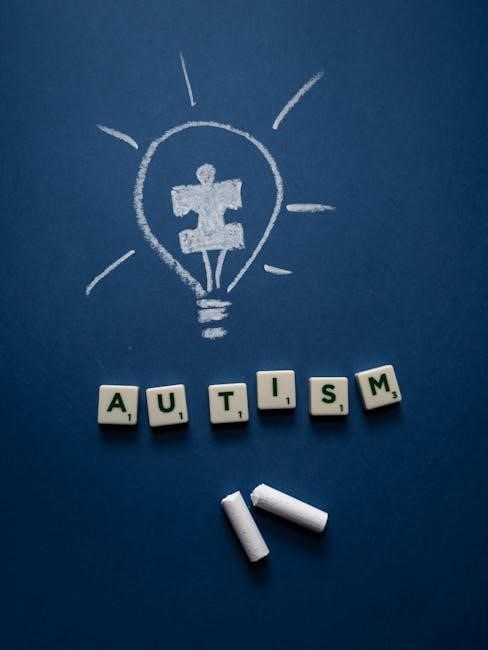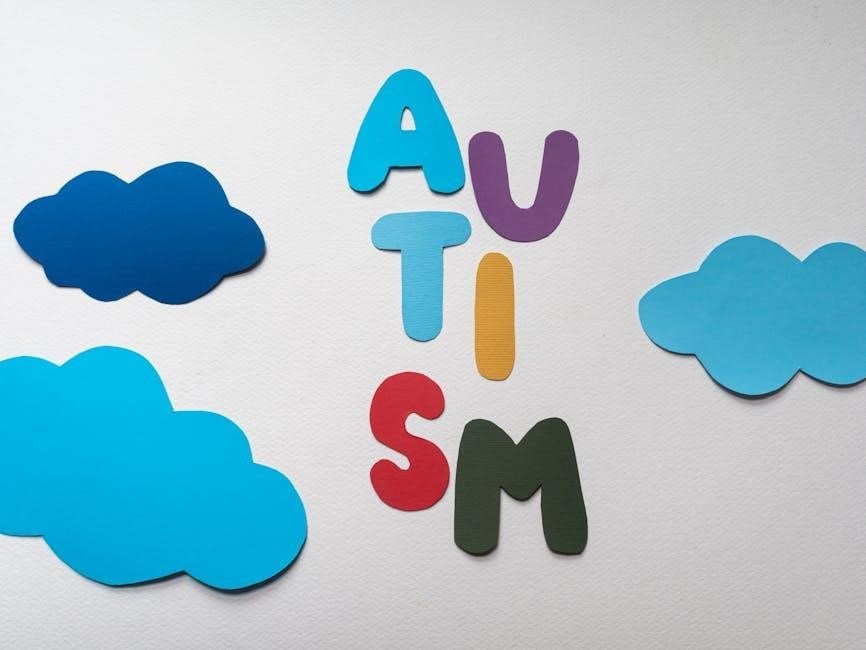The Gilliam Autism Rating Scale (GARS) is a diagnostic tool aiding professionals in identifying autism spectrum disorder (ASD). Developed by James E. Gilliam, it provides reliable measures of autism symptoms across age groups, widely used in clinical and educational settings.
1.1 Definition and Purpose of the GARS
The Gilliam Autism Rating Scale (GARS) is a standardized diagnostic tool designed to identify and assess autism spectrum disorder (ASD) in individuals. Its primary purpose is to evaluate autism-related symptoms, providing a reliable and valid measure of behavioral characteristics. The GARS is used by professionals, such as psychologists, educators, and clinicians, to aid in early identification and diagnosis. It focuses on key areas, including social interaction, communication, and repetitive behaviors. By offering standardized criteria, the GARS ensures consistent and accurate diagnoses across different settings. The tool is particularly valuable for guiding intervention strategies and supporting individuals with autism in clinical and educational environments. Its structured framework helps professionals understand an individual’s unique needs, enabling tailored support plans.
1.2 Historical Background and Development
The Gilliam Autism Rating Scale (GARS) was developed by James E. Gilliam to provide a reliable tool for identifying and assessing autism spectrum disorder (ASD). First introduced, GARS aimed to address the need for a standardized measure of autism symptoms. Over time, the scale has undergone revisions, with the third edition (GARS-3) being the most current. This edition aligns with the Diagnostic and Statistical Manual of Mental Disorders, Fifth Edition (DSM-5), ensuring it reflects contemporary understanding of ASD. The GARS-3 incorporates feedback from professionals and research, enhancing its validity and usability. Its development emphasizes early detection and accurate diagnosis, making it a trusted resource in both clinical and educational settings. The evolution of GARS underscores its commitment to improving ASD assessment and supporting individuals with autism.
1.3 Importance of the GARS in Autism Assessment
The Gilliam Autism Rating Scale (GARS) holds significant importance in autism assessment due to its ability to provide a standardized and reliable evaluation of autism symptoms. It is widely recognized for its role in early detection, which is critical for initiating timely interventions. GARS offers a comprehensive profile of an individual’s strengths and challenges, enabling professionals to develop targeted support strategies. Its structured approach ensures consistency in diagnosis, reducing variability across assessors. Additionally, GARS is valued for its ability to guide the creation of individualized education plans (IEPs) and behavioral interventions. By focusing on key areas such as social interaction, communication, and repetitive behaviors, GARS equips educators, clinicians, and caregivers with essential insights to improve outcomes for individuals with autism. Its accessibility and ease of use make it a vital tool in both clinical and educational settings.

Structure and Components of the GARS-3
The GARS-3 includes an Examiner’s Manual, 50 Summary/Response Forms, and an Instructional Objectives booklet. It assesses six key areas aligned with DSM-5 criteria for autism diagnosis.
2.1 Overview of the GARS-3
The GARS-3 is a comprehensive diagnostic tool designed to assess autism spectrum disorder (ASD) in individuals aged 3 to 22. It includes an Examiner’s Manual, 50 Summary/Response Forms, and an Instructional Objectives booklet. The Examiner’s Manual provides detailed administration and scoring instructions, while the Summary/Response Forms capture demographic information and responses to scale items. The Instructional Objectives booklet offers practical guidance for developing targeted interventions. The GARS-3 evaluates key areas such as social interaction, communication, and repetitive behaviors, aligning with DSM-5 criteria. It is widely used by psychologists, educators, and clinicians to identify ASD symptoms and guide intervention strategies. The tool emphasizes early detection and personalized support, making it a valuable resource for both diagnostic and educational purposes. Its structured approach ensures reliability and validity in assessing autism symptoms across diverse settings.
2.2 Subscales of the GARS-3
The GARS-3 consists of six subscales designed to evaluate specific behaviors and characteristics associated with autism spectrum disorder (ASD). These subscales include:
- Restricted/Repetitive Behaviors: Assesses repetitive actions and stereotyped behaviors, such as hand-flapping or object manipulation.
- Social Interaction: Evaluates the ability to engage with others, including eye contact and peer relationships.
- Social Communication: Measures verbal and non-verbal communication skills, such as language development and gesture use.
- Emotional Responses: Examines emotional regulation and appropriateness of emotional expressions.
- Cognitive Style: Focuses on cognitive processing patterns, including attention to detail and problem-solving approaches.
- Maladaptive Speech: Identifies atypical speech patterns, such as echolalia or unusual tone.
These subscales align with DSM-5 criteria, ensuring a comprehensive assessment of ASD symptoms.
2.3 Administration and Scoring Process
2.4 Interpretation of Results
The GARS-3 results are interpreted using standard scores, percentile ranks, and severity levels to determine the likelihood of autism spectrum disorder (ASD). Scores are categorized into four probability levels: Below Average, Average, Very High, and Extremely High. Higher scores indicate greater severity of autism-related behaviors. The Examiner’s Manual provides guidelines for interpreting these scores, ensuring consistency across evaluations. Professionals use these results to guide diagnosis, develop intervention plans, and monitor progress over time. The interpretation process emphasizes understanding the individual’s strengths and challenges, enabling tailored support strategies. Accurate interpretation requires a comprehensive understanding of the assessment tool and the individual’s unique circumstances.

Applications of the GARS in Clinical and Educational Settings
The GARS is widely used by psychologists, educators, and clinicians to assess autism symptoms, guide diagnosis, and inform intervention strategies. It supports the development of tailored educational plans and therapeutic approaches.
3.1 Use in Diagnosing Autism Spectrum Disorder (ASD)
The GARS is instrumental in diagnosing Autism Spectrum Disorder (ASD) by assessing key behavioral domains such as social interaction, communication, and repetitive behaviors. It provides standardized scores and severity levels, aiding professionals in determining the likelihood of ASD. The tool’s structured framework ensures consistency across evaluations, making it a reliable aid in clinical diagnoses. By identifying specific symptom patterns, the GARS helps differentiate ASD from other conditions, enabling accurate diagnoses. Early detection through GARS facilitates timely interventions, improving outcomes for individuals with ASD. Its user-friendly design allows educators and clinicians to integrate it seamlessly into assessment protocols, making it a valuable resource in both clinical and educational settings.
3.2 Role in Developing Individualized Education Plans (IEPs)
The GARS plays a pivotal role in shaping Individualized Education Plans (IEPs) by identifying specific strengths and challenges in students with ASD. The scale’s subscales—such as Social Interaction, Communication, and Restricted/Repetitive Behaviors—provide detailed insights into a student’s needs, enabling educators to set targeted goals. For example, if a student scores low on Social Communication, the IEP might include objectives to enhance conversational skills or initiate peer interactions. GARS results also guide the selection of appropriate interventions, such as speech therapy or behavioral support. By aligning IEP goals with GARS findings, educators ensure a personalized approach, fostering academic and social growth. This integration of assessment data into educational planning underscores the GARS’s practical value in supporting students with ASD.
3.3 Guiding Behavioral Interventions
The GARS provides critical insights for designing and implementing behavioral interventions tailored to individuals with ASD. By identifying specific behavioral challenges, such as social communication difficulties or repetitive behaviors, the GARS helps professionals target areas needing support. For instance, high scores on the Restricted/Repetitive Behaviors subscale may indicate the need for interventions like sensory integration or positive reinforcement techniques. Similarly, deficits in Social Interaction can guide the implementation of social skills training or peer mentoring programs. The scale’s results enable clinicians and educators to prioritize interventions, ensuring a focused and effective approach. This alignment of assessment data with intervention strategies enhances the likelihood of positive outcomes, making the GARS a valuable tool in behavioral planning for individuals with ASD.
3.4 Supporting Families and Caregivers
The GARS plays a vital role in supporting families and caregivers by providing them with a clear understanding of their child’s strengths and challenges. The results from the GARS help parents and caregivers identify specific areas where their child may need additional support, enabling them to advocate more effectively for their child. The scale’s detailed reports and instructional resources, such as the Instructional Objectives for Individuals Who Have Autism booklet, offer practical guidance for developing strategies to aid their child’s development. By fostering collaboration between families and professionals, the GARS empowers caregivers to create a supportive environment that addresses their child’s unique needs. This collaborative approach not only enhances the child’s quality of life but also equips families with the tools and knowledge necessary to navigate the complexities of autism effectively.

Psychometric Properties of the GARS
The GARS is recognized for its strong reliability and validity, ensuring consistent and accurate autism assessments. However, its limitations include potential cultural bias and diagnostic accuracy concerns.

4.1 Reliability and Validity of the GARS
The GARS is renowned for its strong psychometric properties, particularly its reliability and validity. Reliability refers to the consistency of results when the scale is administered multiple times, ensuring dependable assessments. Validity measures how accurately the GARS evaluates autism symptoms, aligning with diagnostic criteria like the DSM-5. The GARS-3, the latest edition, has undergone rigorous testing to enhance its accuracy and relevance. It effectively distinguishes between individuals with and without ASD, providing clear severity levels. While the GARS is highly regarded, some studies suggest potential limitations, such as cultural bias and diagnostic accuracy concerns. Despite these, its structured approach and alignment with standardized criteria make it a trusted tool in autism assessment, aiding professionals in making informed decisions.
4.2 Comparison with Other Autism Assessment Tools
The GARS is often compared to other autism assessment tools, such as the Autism Diagnostic Observation Schedule (ADOS) and the Childhood Autism Rating Scale (CARS). While the ADOS is considered a gold standard for diagnostic observations, the GARS is praised for its efficiency and ease of use. The CARS, like the GARS, assesses behavioral traits but focuses more on observable behaviors. The GARS-3 stands out for its alignment with DSM-5 criteria and its ability to measure symptom severity across age groups. It is also noted for its shorter administration time compared to the ADOS, making it a practical choice for schools and clinics. However, critics argue that the GARS may lack the depth of observational data provided by tools like the ADOS. Despite this, the GARS remains a widely used and respected instrument in autism assessment.

4.3 Limitations and Criticisms
The GARS has faced criticism for potential cultural bias, as autism symptoms may manifest differently across cultures. Some argue that the scale may not adequately account for these variations, potentially leading to over- or underdiagnosis in diverse populations.
Another limitation is its reliance on observer-reported data, which can introduce subjectivity. Observers may interpret behaviors differently, impacting the accuracy and consistency of results.
The GARS has also been criticized for focusing primarily on deficits rather than strengths, which may overlook the individual’s overall abilities and co-occurring conditions.
Additionally, some professionals argue that the GARS lacks the depth of observational data provided by tools like the Autism Diagnostic Observation Schedule (ADOS), potentially limiting its diagnostic utility in complex cases.
Despite its widespread use, these limitations highlight the need for careful interpretation and supplementation with other assessment methods to ensure comprehensive evaluation.

Cultural Sensitivity and the GARS
The GARS addresses cultural sensitivity by adapting its assessment to diverse contexts, ensuring equitable evaluation across different populations.
5.1 Cultural Considerations in Autism Assessment
Cultural sensitivity is crucial in autism assessment, as behaviors vary across diverse backgrounds. The GARS adapts its criteria to account for cultural differences, ensuring accurate and fair evaluations. This approach minimizes bias and enhances the tool’s effectiveness in multicultural settings. By recognizing that certain behaviors may hold different meanings in various cultures, the GARS supports more reliable diagnoses. For instance, repetitive movements might be perceived differently, impacting assessment outcomes. Therefore, cultural considerations are integral to the GARS, ensuring it remains a valid and unbiased instrument for autism identification worldwide. This adaptability makes the GARS a valuable resource for professionals working with diverse populations, fostering equitable access to accurate diagnoses and appropriate interventions.
5.2 Addressing Cultural Bias in the GARS
The GARS has made strides in reducing cultural bias by incorporating diverse perspectives during its development. Regular updates ensure the tool reflects evolving understanding of autism across cultures. For example, the GARS-3 includes items validated across different populations, minimizing misinterpretation of cultural differences as autistic traits. Additionally, training materials emphasize cultural competence for administrators, ensuring they recognize and account for such nuances. While the GARS is not entirely free from criticism, ongoing efforts aim to enhance its cross-cultural validity. This includes collaborations with international researchers to refine assessment criteria. By addressing cultural bias proactively, the GARS strives to provide equitable and accurate evaluations for individuals from all backgrounds, supporting early and precise diagnoses globally.

Case Studies and Practical Examples
Case studies highlight the GARS’s practical application in real-world settings, such as schools and clinics, demonstrating its effectiveness in guiding tailored interventions for individuals with ASD.
6.1 Example of GARS Administration in a School Setting
In a school setting, the GARS is often administered by a school psychologist or special education professional to identify autism symptoms in students; For example, a 7-year-old student exhibiting social interaction difficulties and repetitive behaviors may be evaluated using the GARS. The administrator observes the student’s behavior, completes the Summary/Response Form, and reviews the results to determine the likelihood of ASD. The GARS-3’s subscales, such as Social Interaction and Restricted/Repetitive Behaviors, provide insights into the student’s specific challenges; Based on the results, the school team develops an Individualized Education Plan (IEP) tailored to the student’s needs, incorporating accommodations like social skills training or behavioral interventions. This example illustrates how the GARS serves as a practical tool for supporting students with autism in educational environments, ensuring they receive appropriate support and resources.
6.2 Impact of GARS Results on Intervention Strategies
The results from the GARS play a pivotal role in shaping intervention strategies for individuals with autism. By identifying specific areas of difficulty, such as social interaction or repetitive behaviors, the GARS enables professionals to develop targeted interventions. For instance, high scores in restricted/repetitive behaviors may prompt the implementation of behavioral therapies to reduce these traits. Similarly, challenges in social communication might lead to speech therapy or social skills training. The GARS also helps in monitoring progress over time, allowing adjustments to intervention plans as needed. This data-driven approach ensures that interventions are tailored to the individual’s unique needs, optimizing their developmental outcomes and quality of life. Ultimately, the GARS serves as a bridge between assessment and action, guiding effective support strategies for individuals with autism.

Future Directions for the GARS
Future updates to GARS may include integration with emerging technologies, enhanced cultural sensitivity, and expanded age ranges to ensure comprehensive and accurate autism assessments.
7.1 Potential Updates and Revisions
Future updates to the GARS may focus on enhancing cultural sensitivity and expanding its applicability across diverse populations. Revisions could include incorporating digital formats for easier administration and scoring.
7.2 Integration with Emerging Technologies
Integrating the GARS with emerging technologies could enhance its accessibility and efficiency. Digital platforms might enable online administration, reducing logistical challenges and increasing reach. AI-driven tools could improve scoring accuracy and provide real-time data analysis.
The GARS is a vital tool in autism assessment, aiding early diagnosis and tailored interventions, significantly improving outcomes for individuals with autism and their families’ well-being.
8.1 Summary of the GARS’s Role in Autism Assessment
The GARS serves as a standardized diagnostic tool, providing a reliable measure of autism symptoms across various age groups. Its structured assessment aids professionals in identifying ASD, evaluating key areas such as social interaction, communication, and repetitive behaviors. By offering standardized criteria, the GARS ensures consistent and accurate diagnoses. It plays a crucial role in early detection, enabling timely interventions that improve the quality of life for individuals with autism. The GARS also guides the development of personalized intervention strategies and educational plans, making it a valuable resource for clinicians, educators, and families. Its widespread use underscores its importance in supporting individuals with autism throughout their lives.

8.2 Final Thoughts on the Importance of Early Diagnosis
Early diagnosis of autism spectrum disorder (ASD) is critical for improving outcomes and enhancing the quality of life for individuals with autism. The GARS plays a pivotal role in facilitating early identification by providing a reliable and standardized framework for assessing autism symptoms. Timely diagnosis enables the implementation of targeted interventions, such as behavioral therapies and educational support, which can significantly impact long-term development. By identifying needs early, professionals and families can work collaboratively to create personalized plans that address specific challenges and foster growth. Early diagnosis not only empowers individuals with autism but also equips caregivers and educators with the tools to provide meaningful support. The GARS, as a diagnostic tool, underscores the importance of early intervention in unlocking potential and improving overall well-being for those on the autism spectrum.
